What about 45-Amp dogbone adapters?
Here's a deep dive into RV shore power adapters and when to use them...
Dear Readers,
A reader recently asked about 45-amp dogbone adapters, and wondered if I had covered that sort of RV hookup already. The answer is yes, but since many of my dogbone adapter articles have been strewn all over the place during the 10 years I’ve been writing for the industry, I’m putting a lot of them together in one place for ease of reference.
Safety first
Note that since safety is my primary concern, I’m not going to suggest or condone anything dangerous. And there are a few adapters that may not be totally code compliant in all states, but which I believe are safe if used properly. However, in all cases you may find that your local electrical inspector (the AHJ, for Authority Having Jurisdiction) has a problem with a certain type of adapter – and it’s within his or her rights to disallow it.
From the beginning
For any new RVers out there, you may not have encountered this problem yet. But you should be aware that just because you have a 30-amp or 50-amp shore power cord on your RV, there’s no guarantee that you’re going to find a matching (and working) electrical outlet at your camping spot. That’s why power cord adapters were created.
The problem is that while there are all sorts of RV power adapters available from major sales sites such as Amazon and eBay, not all of them are safe to use with your RV.
So why do we need adapters?
The answer is that not all campgrounds (and campground pedestals) are created equal. Some of them will have all three types of receptacles (a 20-amp, 30-amp and 50-amp outlet), but many of them will be 30-amp only, or maybe just a single 20-amp outlet in some rural campgrounds.
Yes, but…
So is there a way to plug into electrical power anyway?
The answer is yes, but there’s no way to get blood out of a turnip. That is, you can’t make a 20-amp or 30-amp outlet give you the same amount of power as a 50-amp outlet. And sometimes you can use a 50-amp outlet to power a 30- or even 20-amp RV. You will also find that some older campgrounds have badly worn or miswired pedestals that may be not safe to plug into. And many times there are safe workarounds, but it always has to be done carefully with a full understanding of how much power is available and how much power your RV appliances can demand.
A deeper look….
First, let’s take a look at a full-service pedestal with 50-, 30- and 20-amp outlets. This is typically found in modern RV campgrounds, and it does offer the most flexibility (and power) for your RV’s electrical system, no matter what type of shore power cord it has.
Note that I’m calling this a 100-amp pedestal because it should be capable of providing a full 100 amps of power at 120 volts (50 plus 50 amps). And in many cases it can also supply 30 amps and 20 amps at the same time. But there’s no guarantee it has been wired that way, so caveat emptor.
The candidates
Here, perhaps, is the most common type of adapter you might encounter. Let’s assume you have a 50-amp shore power cord on your RV but need to plug into a 30-amp outlet. Yes, technically the 50-amp connector should be wired for 240 volts, but in actuality it’s two separate legs of 50-amp power at 120 volts, and only the largest coaches actually use 240 volts. So a 30-amp to 50-amp adapter simply feeds the 30-amps of current at 120 volts into both hot legs of your 50-amp shore power cord.
Available power
This works, but with only 3,600 watts of power available from a 30-amp outlet compared to the 12,000 watts you should be able to get from a 50-amp pedestal outlet. From a practical standpoint this suggests you’ll need to do some manual load shedding by not turning on too many high-power appliances at the same time.
That means you won’t be able to run your convection microwave and air conditioner at the same time, and your daughter’s 1,800-watt hair dryer can’t be combined with any other big wattage item. Don’t worry if you go over your 30 amps of allotted power as the circuit breaker in the pedestal or your RV’s load center should trip. Don’t shoot the messenger though, as it’s only doing its job.
Reverse it…
But what if you have a 30-amp shore power RV and you want to plug into a 50-amp pedestal outlet. Is that safe? Will it feed 240 volts into your 120-volt RV and blow it up?
YES, it should be safe
If your RV power center is properly wired with a 30-amp master circuit breaker, then using a 50-amp to 30-amp adapter to plug your 30-amp shore power cord into a 50-amp outlet should be safe from overload.
NO, it won’t feed 240-volts into your RV
This type of adapter won’t accidentally feed 240-volts into your 120-volt RV. But make sure you purchase a quality dogbone adapter since I have seen a few miswired ones from unknown brands.
Isn’t this a code violation?
However, note that this is technically a code violation that your campground (or the local inspector) may not allow. Still, the major manufacturers (Southwire, Camco, etc…_ do build these things, and I agree that in many campgrounds the 30-amp outlets are so worn out that they’re a bigger hazard to plug into as it is.
So, as long as your own shore power cord and RV power panel are properly wired and maintained, there shouldn’t be any danger of overheating the wire with too much current. But always be watchful of any hookup like this because there is a fire hazard if something goes wrong in your RV’s power panel.
What about 50- to 20-amp adapters?
Well, those are in their own extreme danger category since it would be way to easy to plug a 14-gauge extension cord (rated for 15 amps of current) into an outlet that can supply 50 amps of current.
And that’s a recipe for extreme overheating and a fire. If you don’t believe me, watch a video of me overheating a 14-gauge extension cord with 30 amps of current. In 5 minutes it’s approaching the boiling point of water, and I’m sure it would have caught on fire in another 5 minutes of over current. Watch this short video HERE.
Is there a safer version?
However, while you really don’t want to use one of these cheap 50- to 20-amp dogbone adapters, I did find a version that includes a pair of 20-amp circuit breakers, one for each 20-amp duplex outlet.
Note that with the little red push-button circuit breakers, and the heavy wire rated for 50 amps of current, I think this version should be perfectly safe to use at a spare 50-amp pedestal if you need to run a couple of deep fryers or whatever for an outside party. You can buy one of these hard-to-find adapters HERE (when they’re in stock).
What about 30/30 to 50-amp Y adapters?
You can get a double 30-amp male to single 50-amp female Y adapter from companies such as Southwire and Camco. They should work if you can get access to 30-amp outlets on two different pedestals.
However, if both 30-amp outlets on the two pedestals are on the same incoming hot leg, then it’s possible to draw up to 60 amps of current through the 50-amp neutral. But even though that’s technically a code violation, there’s probably limited danger of actual overheating the connection if everything else is clean and maintained. Still, you’ll want to carefully watch for overheating if you’re running a lot of appliances and air conditioners.
What about 15/30 to 45-amp Y adapters?
The big caveat is those 15/30-amp to 50-amp Y adapters, sometimes called 45-amp adapters since they have a 15-amp and 30-amp male plug feeding a 50-amp female outlet. If the pedestal is wired properly with a GFCI on its 20-amp outlet, then the combined neutral currents will cause the GFCI outlet or breaker to instantly trip. If not, then the GFCI has failed or somehow been disabled, which is a serious code violation. So this type of adapter generally won’t work at all.
Never rewire a campground pedestal!
NEVER rewire or replace a GFCI protected 15 or 20-amp outlet with a standard receptacle since that’s a seriou code violation which could leave you liable if someone is shocked. And you certianly don’t want to be poking around inside of a live campground pedestal yourself. Playing with live electricity can make you dead.
Hockey puck adapters
I like dogbone adapters from quality companies such as Camco and Southwire. That’s because nearly every adapter failure I’ve seen has been one of those super-inexpensive puck adapters that were likely not assembled correctly to begin with. Plus they tend to lever the plug contacts out of the outlet from the weight of the cord hanging off of them, so I think they’re a bad idea in general, unless you can properly manage the cord weight twisting problem.
Electricity can be your best friend or your worst enemy if you don’t understand the rules. So let’s play safe out there…. Mike

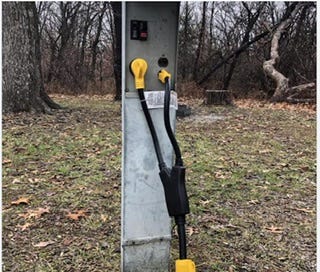



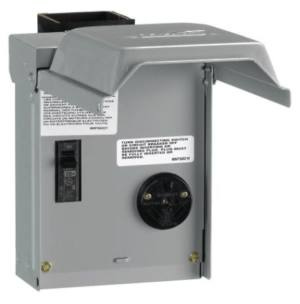



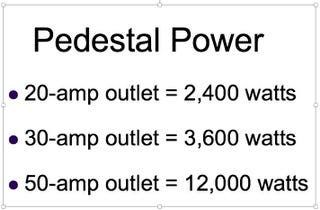
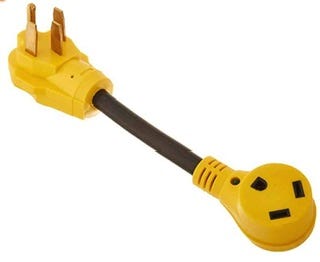
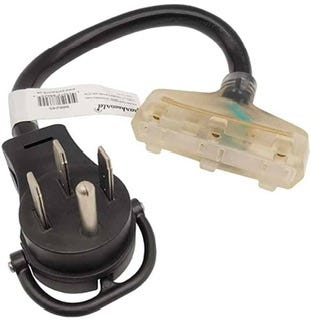
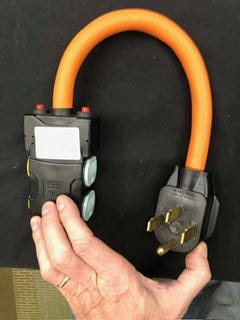
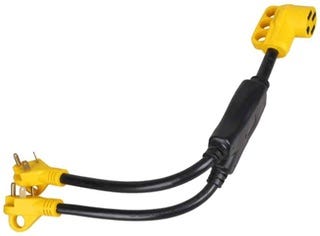
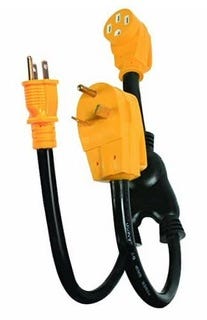
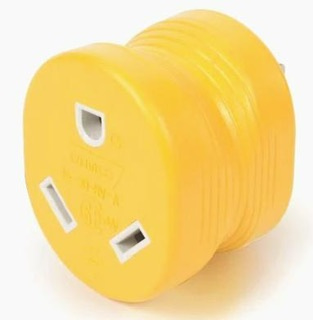

I already covered that here. Let me take a look this afternoon and post a link.
Thank you for the great information.
I recently used an article you wrote about to install a 50 amp RV connecton, installed a breaker at the RV box to cut the power while plugging into and removing the power cord.